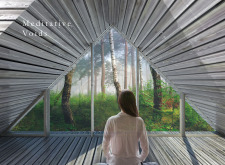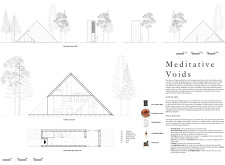5 key facts about this project
The cabin features a triangular form that creates a meditative void at its center, promoting reflection and calm. Located in a forested environment, the design integrates with nature and encourages a deep connection to the surroundings. The concept focuses on practical living, emphasizing functionality while providing a peaceful retreat for occupants.
Geometric Configuration
The triangular shape plays a vital role in shaping the cabin’s identity. The meditative void contrasts with the closed wooden areas, allowing for a sense of spaciousness. This geometry is not just for aesthetics; it plays a part in fostering an environment suitable for contemplation. The form evokes the image of a wooden hill, inviting people to immerse themselves in the natural landscape.
Interior Spaces
Inside, the organization of spaces is clear and purposeful. When entering the cabin, visitors encounter a bathroom area with a shower and a dry toilet. This setup provides essential amenities that prioritize comfort. The kitchen, located at the center, is fitted with a wood stove for cooking and heating. At the opposite end lies a dedicated area for meditation. This arrangement creates an easy flow between different functions, ensuring that each area fulfills its role effectively.
Material Selection
Natural wood is the key material used in the design, contributing to both the look and feel of the cabin. Wood adds warmth and character, making the interior inviting for occupants. Over time, the material will blend with the environment, further enhancing the connection to nature. The choice of wood reflects a commitment to creating a cozy atmosphere.
Sustainable Practices
Sustainability is a core aspect of the cabin's design. It includes practical solutions suitable for short-term stays. Occupants receive necessary supplies, including drinking water stored in jerry cans and solar shower bags that promote outdoor bathing. The dry toilet system helps with waste management, while the evaporative cooler offers a simple form of passive cooling. These features support an eco-friendly approach, making the living experience efficient and mindful.
The design incorporates small, operable windows that connect the interior with the outside world. Fresh air and the sounds of nature flow in, enhancing the overall experience. This detail invites occupants to engage with the forest, reinforcing the cabin’s purpose as a space for reflection and tranquility.






















































